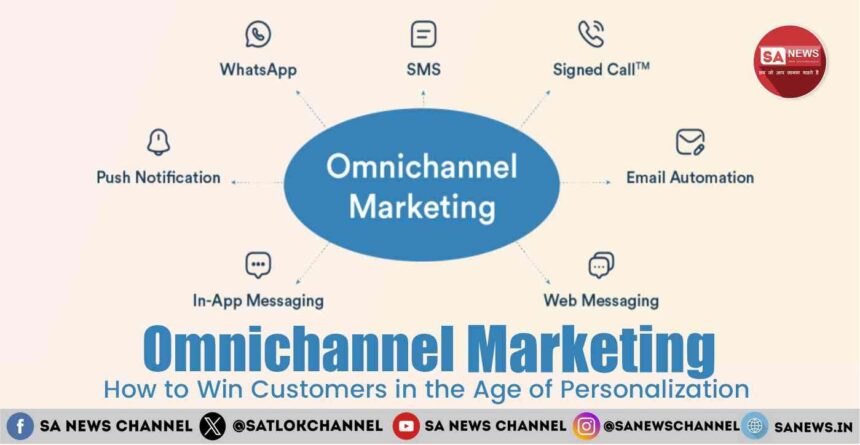Imagine this: a customer spots your product in a TikTok video, adds it to their cart through your website, checks reviews on Google, gets a discount reminder through email, and finally completes the purchase by picking it up in your store the same evening. If each step feels smooth, effortless, and connected, you’ve won a loyal customer. If instead the cart isn’t synced, the discount doesn’t apply in-store, and customer service makes them repeat their story three times, you’ve probably lost them for good.
- Understanding Omnichannel Marketing
- Why Omnichannel Marketing Matters
- Core Benefits of Omnichannel Customer Engagement
- 1. Consistent Brand Experience
- 2. Personalization at Scale
- 3. Loyalty and Retention
- 4. Revenue and ROI
- 5. Richer Insights and Smarter Decisions
- Key Components of an Omnichannel Strategy
- Challenges and Solutions
- Case Studies
- Emerging Trends in Omnichannel Marketing
- Professional Insights
- Best Practices for Success
- Conclusion
This is exactly the gap omnichannel marketing fills. Today’s buyers don’t think in “channels.” They expect a single, unified brand experience, no matter where they interact. Omnichannel marketing creates this by connecting every touchpoint—digital, social, mobile, and in-person—into one seamless journey.
The stakes are high. Studies reveal that 73% of shoppers are already omnichannel customers, and these shoppers spend up to 30% more than those who stick to one channel. Retailers with strong omnichannel strategies report 90% higher customer retention rates, while companies that fail to adopt these models grow 64% slower than their omnichannel competitors. In short: omnichannel marketing isn’t a trend, it’s the survival kit for modern businesses.
Understanding Omnichannel Marketing
Omnichannel marketing integrates all customer touchpoints into a single experience. Whether someone browses your website, checks your mobile app, interacts with a chatbot, or walks into a physical store, the messaging, offers, and data flow must feel connected.
This differs from multichannel marketing. Multichannel uses many platforms but often in silos—an email campaign that doesn’t align with in-store promotions, or a website cart that doesn’t sync with a mobile app. Omnichannel fixes this fragmentation. It makes sure that a customer who abandons their cart online gets a timely push notification and can later redeem the same discount in a physical store without hassle.
Why Omnichannel Marketing Matters
Rising Customer Expectations
Consumers no longer tolerate friction. In fact, 76% of buyers say they get frustrated when personalization is missing, while 31% remain loyal because of it. Modern shoppers want their preferences remembered, offers tailored, and service consistent across channels.
Competitive Necessity
Global giants like Amazon, Apple, and Nike already thrive on omnichannel models. They offer services such as same-day delivery, in-app recommendations, and in-store pickup – raising the bar for everyone else. Businesses that can’t match these standards risk becoming irrelevant.
Technology Democratization
Affordable Customer Data Platforms (CDPs), cloud-based CRMs, and AI-powered automation tools are now accessible even to small and medium businesses. What was once a luxury for enterprise players is now within reach for startups and local retailers.
Tangible ROI
Omnichannel campaigns boost buy rates by 287%, improve average order value by 13%, and increase revenue by 9.5%. These are not marginal gains – they’re transformative.
Core Benefits of Omnichannel Customer Engagement
1. Consistent Brand Experience
Brand recognition thrives on consistency. Whether it’s an Instagram story, a promotional SMS, or a loyalty app notification, the brand’s tone, design, and value proposition must feel identical. When this is achieved, customers don’t think about “channels”—they simply recognize and trust the brand.
2. Personalization at Scale
With unified data, businesses can move beyond broad segments to hyper-personalized engagement. A shopper who browsed sneakers online can get an email with shoe recommendations, a push notification with a location-based discount, and an in-store associate who already knows their preferences. Companies using advanced personalization strategies report 5–8× ROI and sales lifts of 10% or more.
3. Loyalty and Retention
Loyalty is no longer about points alone—it’s about convenience and trust. Omnichannel customers, who enjoy frictionless journeys, spend 20% more and return more often. Businesses with strong omnichannel engagement achieve 89% customer retention, far above industry averages.
4. Revenue and ROI
Every additional integrated channel compounds the returns. Businesses running campaigns across three or more channels see 250% higher engagement rates than those sticking to one. Over time, this translates into significantly higher revenue and longer customer lifetimes.
5. Richer Insights and Smarter Decisions
Instead of analyzing each channel separately, omnichannel marketing aggregates data across touchpoints. This provides a 360° view of the customer journey, enabling smarter budget allocation and campaign refinement.
Also Read: Digital Marketing Blueprint: From Clicks to Clients
Key Components of an Omnichannel Strategy
- Centralized Customer Data
Data is the backbone. A unified CRM or CDP collects interactions from all touchpoints—web visits, app usage, purchases, support chats—and consolidates them into a single customer view. - Customer Journey Mapping
Mapping how customers interact—from awareness to purchase and beyond—helps brands identify drop-off points and fix bottlenecks. - Consistent Messaging
A discount offered by email must appear in-app and at checkout in store. Inconsistency breaks trust. - Automation and AI
Automation ensures timely engagement, like cart abandonment reminders. AI predicts behaviour—anticipating needs, suggesting products, and optimizing channel selection. - Measurement and Optimization
KPIs such as cross-channel conversion, customer lifetime value, and engagement scores allow continuous testing and improvement. - Privacy and Compliance
With greater data comes greater responsibility. Transparency, consent, and security are essential. Research shows 63% of consumers willingly share data if experiences improve significantly.
Challenges and Solutions
- Data Silos: Fragmented data undermines personalization. Fix with integration tools and CDPs.
- Team Misalignment: Conflicting promotions across channels confuse customers. Cross-functional KPIs and shared calendars solve this.
- Over-Automation: Excess notifications cause fatigue. Use behaviour-based triggers and cap frequency.
- High Costs: Full-scale omnichannel systems can be expensive. Start with the most impactful channels and expand.
- Privacy Risks: Collect only necessary data, get clear consent, and comply with GDPR/CCPA.
Case Studies
Apparel Retailer Example
A fashion retailer connected its website, app, and physical outlets. Customers could save items online, get app alerts when discounts went live, and find the same items in stock in nearby stores. This strategy lifted repeat purchases by nearly 18%.
Local Coffee Chain
A café combined SMS, email, and an app-based loyalty program. Customers received personalized offers and saw their loyalty points update instantly across all platforms. Result: repeat visits rose 25% within six months.
Emerging Trends in Omnichannel Marketing
- Conversational Commerce: Shopping directly through chatbots and messaging apps is on the rise.
- AR & VR Experiences: Customers preview furniture in their living room through AR apps before buying.
- Unified Loyalty Programs: One ID, one currency of points, usable across online and offline channels.
- Predictive AI Engagement: Algorithms predict when and where a customer will engage next, sending timely nudges.
- Retail Media Networks (RMNs): Expected to hit $179.5 billion in spending by 2025, these networks leverage omnichannel consumer data for hyper-targeted ads.
Professional Insights
Industry practitioners stress that the hardest part of omnichannel is not technology but alignment: “The biggest roadblock is people and process—not platforms.” Companies must invest as much in organizational structure as in tools.
Best Practices for Success
- Start with key channels most used by your audience.
- Align marketing, sales, and support with shared KPIs.
- Clean and update data regularly.
- Balance automation with human support to avoid robotic interactions.
- Continuously test and refine messages, formats, and timing.
- Protect privacy and build trust by being transparent about data use.
Conclusion
Omnichannel marketing is not optional—it is the future of customer engagement. Customers demand seamless, personalized, cross-channel journeys, and the data proves that businesses delivering this outperform those that don’t. By unifying data, aligning teams, leveraging AI, and respecting privacy, brands can achieve stronger loyalty, higher revenue, and long-term growth.
Beyond Omnichannel: A Path Toward Deeper Connection
As businesses embrace omnichannel marketing to engage customers seamlessly across every touchpoint, a larger truth emerges—connection itself is at the heart of human experience. Just as consistent messaging builds loyalty in the marketplace, alignment between our inner self and the eternal divine builds purpose in life. True engagement extends beyond screens, stores, and digital platforms into questions of why we exist and how to find lasting fulfillment. For those seeking to deepen this journey, spiritual wisdom can provide answers. Books like “Gyan Ganga“ and “Way of Living” by Saint Rampal Ji Maharaj offer clear guidance on authentic worship practices, helping readers move beyond temporary interactions toward a meaningful, enlightened existence.









